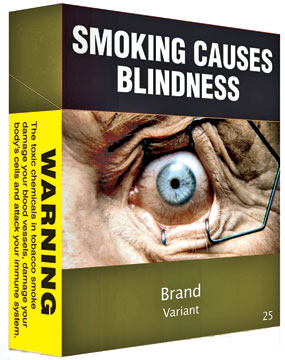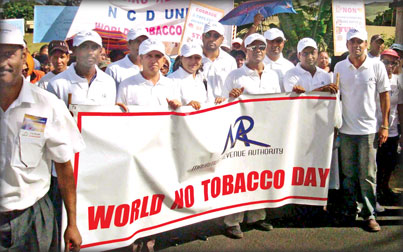|
World No Tobacco Day on Tuesday:
Bid goodbye to a vile habit
By Pramod DE SILVA
Smoking Kills. It is not only a slogan, it is also a fact. Smoking -
direct and passive - kills six million people every year around the
world. Millions more get a death sentence in the form of lung or mouth
cancer. Smoking is a cancer that we can do without, for it adds nothing
to our lives except misery. And it reduces years from the lives of those
who smoke.
 Apart from the six million people around the world who die each year
from direct tobacco use, or exposure to tobacco products, around 600,000
non-smokers are affected by second-hand smoke. Unless more people decide
to give up smoking, the habit could kill up to one billion people in the
21st century. Apart from the six million people around the world who die each year
from direct tobacco use, or exposure to tobacco products, around 600,000
non-smokers are affected by second-hand smoke. Unless more people decide
to give up smoking, the habit could kill up to one billion people in the
21st century.
Because tobacco use is growing most steadily in low and middle-income
countries, by 2030, more than 80 percent of tobacco deaths will be in
these countries. Smoking is, therefore, not only a public health
priority, but also a key development issue.
If you still smoke, there is still time to quit. There is an occasion
just around the corner which will help you make this life-changing
decision. The special event is the World No Tobacco Day, which falls on
May 31.
The World No Tobacco Day is observed worldwide every year to
encourage tobacco users to abstain from consuming of all forms of
tobacco for at least 24 hours. But smokers are encouraged to give it up
for life.
The World No Tobacco Day was initiated in 1987, when the World Health
Assembly (WHA) of the World Health Organization (WHO) passed a
resolution which ultimately formed the World No Tobacco Day (WNTD).
The primary objective of WNTD was to enlighten people about the
deadly components of tobacco and its repercussions. The lead
organisation of the UN for WNTD is the WHO.
Each year, on this day, the WHO chooses a theme that carries global
messages to quit smoking and to raise awareness on the dangers of
smoking. This year, the WHO has gone a step further and highlighted a
theme that stresses the legal side of tobacco prevention, as opposed to
the usual 'awareness' themes.
The WHO in January 2011 selected 'The WHO Framework Convention on
Tobacco Control' (FCTC), which is considered the world's primary tobacco
curbing instrument, as the theme of this year's WNTD events.
First treaty
The first treaty ever negotiated under the auspices of WHO, it
represents a signal achievement in the advancement of public health. In
force since 2005, it is already one of the most rapidly and widely
embraced treaties in the history of the United Nations, with more than
170 Parties.
The World No Tobacco Day 2011 will highlight the treaty's overall
importance, to stress countries' obligations under the treaty and
promote the essential role of the Conference of the Parties and WHO in
supporting countries' efforts to meet those obligations.
The WHO notes that "The world needs the WHO FCTC as much as, if not
more than, it did in 1996 when the World Health Assembly adopted a
resolution calling for an international framework convention on tobacco
control".
According to the WHO, tobacco use is the leading preventable cause of
death. This year, more than six million people will die from a
tobacco-related heart attack, stroke, cancer, lung ailment or other
disease.
This does not include the more than 600,000 people - more than a
quarter of them children - who will die from exposure to second-hand
smoke. The annual death toll from the global epidemic of tobacco use
could rise to eight million by 2030, less than 20 years away.
The WHO FCTC confers legal obligations on its countries (and the
European Union) that have formally acceded to it:
Among these obligations are those to:
* Protect public health policies from commercial and other vested
interests of the tobacco industry,
* Adopt price and tax measures to reduce the demand for tobacco,
 * Protect people from exposure to tobacco smoke, * Protect people from exposure to tobacco smoke,
* Regulate the contents of tobacco products,
* Regulate tobacco product disclosures,
* Regulate the packaging and labelling of tobacco products,
* Warn people about the dangers of tobacco,
* Ban tobacco advertising, promotion and sponsorship,
* Offer people help to end their addiction to tobacco,
* Control the illicit trade in tobacco products,
* Ban cigarette sales to and by minors,
* Support economically viable alternatives to tobacco growing.
The treaty also recognises the importance of international
cooperation and of helping low and middle-income countries to meet their
treaty obligations.
Key message
The campaign will focus on the following key message: that countries
must fully implement the treaty to protect present and future
generations from the devastating health, social, environmental and
economic consequences of tobacco consumption and exposure to tobacco
smoke.
On World No Tobacco Day 2011, and throughout the following year, the
WHO will urge countries to put the treaty at the heart of their efforts
to control the global epidemic of tobacco use. By heeding WHO's call,
countries will enhance their ability to significantly reduce the toll of
tobacco-related diseases and deaths in line with their treaty
obligations.
Sri Lanka, a Party to the Treaty, is one of the most prominent
success stories in the fight against tobacco use. It has taken many
measures to curb smoking and the new laws passed a couple of years ago
give law enforcement authorities enhanced powers to deal with
tobacco-related offences.
Yet, millions of cigarettes are sold daily and nearly 20,000 persons
die each year in Sri Lanka from tobacco-related complications. These are
precious lives that could be saved just by one single act - giving up
smoking for good. Doctors and health campaigners around the world,
including those in Sri Lanka, will be urging smokers to give up their
habit. They will point out the many benefits that stopping smoking can
bring - including better overall health, more money and higher
fertility.
Doctors are aware that for addicts, giving up smoking is not easy.
Nicotine and other addictive chemicals in cigarettes can make giving up
extremely difficult. But with the right guidance and enough will-power,
becoming smoke-free is perfectly possible. There are many proven
programs that help smokers to literally kick the butt.
 |
|
A demonstration against
smoking |
In the meantime, more countries are taking legislative measures to
curb smoking. In New York, smoking is being banned in most public places
including parks. Australia is set to introduce plain packaging for
cigarettes, with huge warnings on the dangers of smoking (See picture,
top left). This could be emulated by other countries if successful in
Australia.
Currently, branded cigarette packs have warnings, but only in small
print. Also in Australia, there is even talk of smokers having to obtain
a pricey 'licence' for the privilege, though the controversial move is
still being debated.
Anti-smoking laws
The tobacco industry, while outwardly showing signs of complying with
international anti-smoking laws, resorts to various means to spread the
habit worldwide, especially among youth. With tobacco advertising
completely banned since 2008, they are finding novel methods to
popularise cigarettes. It is important to defeat these attempts at local
and international level. The media too must play a more pro-active role
in tobacco prevention. No country has so far completely banned tobacco,
the only legally available drug in most countries.
But the idea is to implement various measures to discourage smoking
to the point that lighting up is almost impossible anywhere except at
one's home. If more people give up smoking either voluntarily or through
the force of restrictive laws, it will be a major victory for
governments and health services worldwide. It will help millions of
unnecessary deaths, save a vast amount of money (the health cost of
smoking is enormous) and result in a healthier next generation. And we
will all be able to breathe some fresh air, at last.
|

